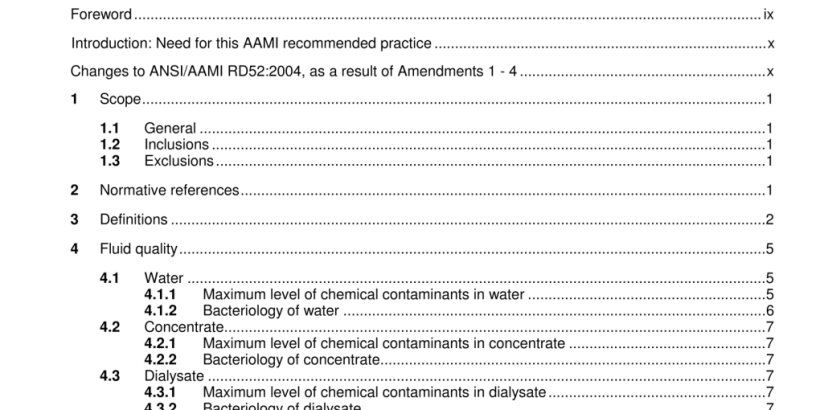ANSI AAMI RD52-2004 pdf download.Dialysate for hemodialysis
1.1 General
The intent of this recommended practice is to provide dialysis practitioners with guidance on the preparation of dialysate for hemodialysis and related therapies, from the point at which municipal water enters their dialysis facility to he point at which the final dialysate enters the dialyzer. Included in the scope of the recommended practice are: (1) use,maintenance, and monitoring of equipment used to purify and distribute water used for the preparation of dialysate and other hemodialysis applications; (2) use, maintenance, and monitoring of equipment used to prepare concentrate from powder at a dialysis facility; and (3) preparation of the final dialysate from purified water and concentrate. The equipment used in the various stages of dialysate preparation is generally obtained from specialized vendors. This recommended practice provides a general description of the system components that these vendors may provide. These descriptions are intended to provide the user with a basis for understanding why certain equipment may be required and how it should be configured; they are not intended as detailed design standards. Dialysis practitioners are generally responsible for maintaining the equipment used to prepare dialysate following its installation. Therefore, this recommended practice provides guidance on monitoring and maintenance of the equipment to ensure that dialysate quality is acceptable at all times. At various places throughout this recommended practice, the user is advised to follow the manufacturer’s instructions regarding the operation and maintenance of equipment. In those instances in which the equipment is not obtained from a specialized vendor, it is the responsibility of the user to validate the performance of the equipment in the hemodialysis setting and to ensure that appropriate operating and maintenance manuals are available.
The guidance provided by this recommended practice should help protect hemodialysis patients from adverse effects arising from known chemical and microbial contaminants that may be found in improperly prepared dialysate. However, the physician in charge of dialysis has the ultimate responsibility for ensuring that the dialysate is correctly formulated and meets the requirements of all applicable quality standards.
1.2 Inclusions
This recommended practice addresses the user’s responsibility for the dialysate once equipment has been delivered and installed. For the purposes of this recommended practice, the dialysate includes water used for the preparation of dialysate, water used for the preparation of concentrates at the user’s facility, and water used for the preparation of ultrapure dialysate, as well as the final dialysate and concentrates. Because it is commonly prepared and distributed using the same equipment as the water used to prepare dialysate, water used to reprocess dialyzers is also covered by this recommended practice. This recommended practice includes an annex containing recommendations for home hemodialysis.
3.17 dialysate: Aqueous fluid containing electrolytes and, usually, dextrose, which is intended to exchange solutes with blood during hemodialysis. The word“dialysate” is used throughout this document to mean the fluid made from water and concentrates that is delivered to the dialyzer by the dialysate supply system. Such phrases as“dialyzing fluid” or“dialysis solution” may be used in place of dialysate.
3.18 dialysate supply system: Devices that: (1) prepare dialysate on-line from water and concentrates or that store and distribute premixed dialysate; (2) circulate the dialysate through the dialyzer; (3) monitor the dialysate for temperature, conductivity (or equivalent), pressure, flow, and blood leaks; and (4) prevent dialysis during disinfection or cleaning modes. The term includes reservoirs, conduits, proportioning devices for the dialysate, and monitors and associated alarms and controls assembled as a system for the characteristics listed above. The dialysate supply system is often an integral part of single-patient dialysis machines (see 2.2).
3.19 disinfection: Destruction of pathogenic and other kinds of microorganisms by thermal or chemical means. Disinfection is a less lethal process than sterilization, because it destroys most recognized pathogenic microorganisms but does not necessarily destroy all microbial forms. This definition of“disinfection” is equivalent to low-level disinfection in the Spalding classification.ANSI AAMI RD52-2004 pdf download
